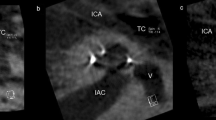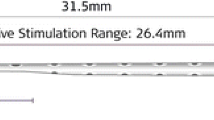Abstract
The question addressed here is how optimizing the quality of insertion through the round window with the lower morbidity, when using a straight and slotted electrode array of regular length. This retrospective analysis includes all cases implanted with a cochlear implant Digisonic SP (Neurelec-Oticon Medical) since 2004. We checked the operative charts, the depth of insertion, and the follow-up. For comparisons, contingency tables were used and a Chi-square test was performed. A p value <0.05 was considered significant. 126 cases of patients with non-malformed cochleas were implanted through the round window. The mean age was 53.8 ± 16.2 for adults and 3.6 ± 2.6 for children (24 cases). The mean follow-up was 33 ± 22 months. The straight electrode array had either a square or a soft pointed tip (n = 84). Full insertion was achieved in 79 out of 84 cases with a soft tip vs. 18 out of 42 square tips (χ 2 = 41.41, DOF = 1, p < 0.0001). Two cases were stuck at the round window niche by a prominent crista fenestrae. In all cases but one, the chorda tympany was preserved. In one case, a misrouting to the vestibule required a revision surgery. Implantation through the round window with a straight and slotted electrode array with a soft tip (Digisonic SP, Neurelec-Oticon Medical) can lead to a full insertion in 94 % of cases. Drilling out a prominent crista fenestrae is recommended.





Similar content being viewed by others
References
Friesen LM, Shannon RV, Baskent D, Wang X (2001) Speech recognition in noise as a function of the number of spectral channels: comparisons of acoustic hearing and cochlear implants. J Acoust Soc Am 110:1150–1163
Hoffman RA (1997) Cochlear implant in the child under two years of age: skull growth, otitis media, and selection. Otolaryngol Head Neck Surg 117:217–219
Kashio A, Sakamoto T, Karino S, Kakigi A, Iwasaki S, Yamasoba T (2015) Predicting round window niche visibility via the facial recess using high-resolution computed tomography. Otol Neurotol 36:e18–e23. doi:10.1097/MAO.0000000000000644
Guevara N, Sterkers O, Bébéar JP, Meller R, Magnan J, Mosnier I, Amstutz I, Lerosey Y, Triglia JM, Roman S, Gahide I (2010) Multicenter evaluation of the digisonic SP cochlear implant fixation system with titanium screws in 156 patients. Ann Otol Rhinol Laryngol 119:501–505
Adunka O, Unkelbach MH, Mack M, Hambek M, Gstoettner W, Kiefer J (2004) Cochlear implantation via the round window membrane minimizes trauma to cochlear structures: a histologically controlled insertion study. Acta Otolaryngol 124:807–812
Briggs RJ, Tykocinski M, Xu J, Risi F, Svehla M, Cowan R, Stover T, Erfurt P, Lenarz T (2006) Comparison of round window and cochleostomy approaches with a prototype hearing preservation electrode. Audiol Neurootol 11(Suppl 1):42–48
Roland PS, Wright CG, Isaacson B (2006) Cochlear implant electrode insertion: the round window revisited. Laryngoscope 117:1397–1402
Skarzynski H, Lorens A, Piotrowska A, Anderson I (2007) Preservation of low frequency hearing in partial deafness cochlear implantation (PDCI) using the round window surgical approach. Acta Otolaryngol 127:41–48
Li PM, Wang H, Northrop C, Merchant SN, Nadol JB Jr (2007) Anatomy of the round window and hook region of the cochlea with implication for cochlear implantation and other endocochlear surgical procedures. Otol Neurotol 28:641–648
Kang BJ, Kim AH (2013) Comparison of cochlear implant performance after round window electrode insertion compared with traditional cochleostomy. Otolaryngol Head Neck Surg 148:822–826
Atturo F, Barbara M, Rask-Andersen H (2014) On the anatomy of the ‘hook’ region of the human cochlea and how it relates to cochlear implantation. Audiol Neurootol 19:378–385
Nguyen Y, Miroir M, Kazmitcheff G, Sutter J, Bensidhoum M, Ferrary E, Sterkers O, Bozorg Grayeli A (2012) Cochlear implant insertion forces in microdissected human cochlea to evaluate a prototype array. Audiol Neurootol 17:290–298
Parisier SC, Chute PM, Popp AL, Hanson MB (1997) Surgical techniques for cochlear implantation in the very young children. Otolaryngol Head Neck Surg 117:248–254
Kronenberg J, Migirov L, Dagan T (2001) Suprameatal approach: new surgical approach for cochlear implantation. J Laryngol Otol 115:283–285
Kronenberg J, Migirov L, Baumgartner WD (2002) The suprameatal approach in cochlear implant surgery: our experience with 80 patients. ORL J Otorhinolaryngol Relat Spec 202:403–405
Häusler R (2002) Cochlear implantation without mastoidectomy: the pericanal electrode insertion technique. Acta Otolaryngol 122:715–719
Taibah K (2009) The transmeatal approach: a new technique in cochlear and middle ear implants. Cochlear Implants Int 10:218–228
Slavutsky V, Nicemboi L (2009) Preliminary results in cochlear implant surgery without antromastoidectomy and with atraumatic electrode insertion: the endomeatal approach. Eur Arch Otorhinolaryngol 266:481–488
Guevara N, Bailleux S, Santini J, Castillo L, Gahide I (2010) Cochlear implantation without posterior tympanotomy: can we still improve it? Acta Otolaryngol 130:37–41
Mom T (2011) Cochlear implantation through a posterior tympanotomy: adaptation of the surgical technique for selective cases in young children. 10th Eur Symp Pediatr Coch Implant. Medimond International Proceedings, Bologna, pp 47–51
Della Volpe A, Cantore I, Nolè G, Valente P, Varricchio AM, Santandrea M, Santandrea V, Cantore R (2012) Combined posterior tympanotomy/endomeatal access in cochlear implantation. Eur Arch Otorhinolaryngol 270:2641–2648
Souter MA, Briggs RJ, Wright CG, Roland PS (2011) Round window insertion of precurved perimodiolar electrode arrays: how successful is it? Otol Neurotol 32:58–63
Richard C, Fayad JN, Doherty J, Linthicum FH Jr (2012) Round window versus cochleostomy technique in cochlear implantation: histologic findings. Otol Neurotol 33:1181–1187
Conflict of interest
Authors declare no conflict of interest.
Author information
Authors and Affiliations
Corresponding author
Rights and permissions
About this article
Cite this article
Mom, T., Bachy, A., Houette, A. et al. Cochlear implantation through the round window with a straight slotted electrode array: optimizing the surgical procedure. Eur Arch Otorhinolaryngol 273, 853–858 (2016). https://doi.org/10.1007/s00405-015-3623-8
Received:
Accepted:
Published:
Issue Date:
DOI: https://doi.org/10.1007/s00405-015-3623-8




